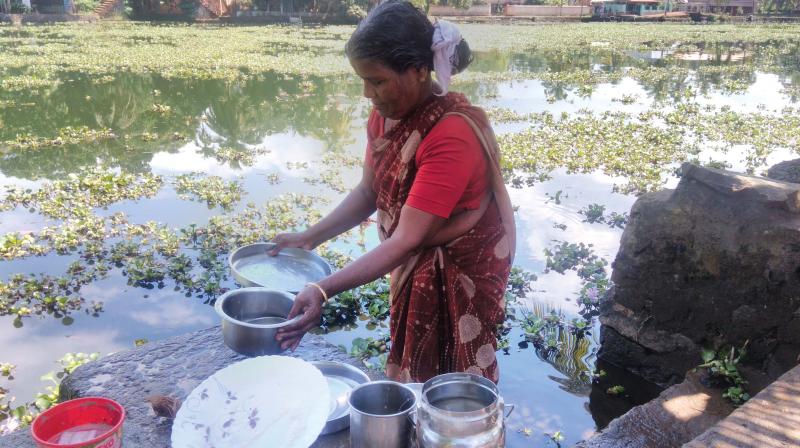Polluted Kuttanad in deep waters
The water-logged region is forced to pay for potable water; those who can't afford put their health at risk.

Alappuzha: The water-logged Kuttanad is thirsting for safe water with the people now depending on polluted rivers and streams for their daily needs. The excessive use of pesticides by the paddy farmers and the absence of summer rains have made the lives of the people miserable. A common sight now in Kuttanad villages is the long queues of women waiting with pots to carry water from all the sources available. Kuttanad is blessed with the downstreams of four rivers--Meenachal, Pampa, Punnamada and Achankovil. But 80 percent of the people do not have safe drinking water. The water level in the rivers has also gone down. Moreover, most of the households keep an outlet of their toilets into the river.
“We have developed an immunity to diseases,” said Santhamma, a housewife, of Kanakari, which is the worst-hit village in Kuttanad, where there are 54 villages. Kainakari, with over 6,000 households and 30,000 people, does not have even one public tap. “No poison can kill us as we are used to it,” said another woman, Padmavathi, 62. “We pay Rs 10 for a pot of water supplied by private agencies from Alappuzha town,” she said. Leelama, 58, a homemaker of Thattassery, Kavalam, said her village did not have piped water for a year due to the neglect by the water authority. “Many of us depend on the polluted water as we cannot spend '750 every month for buying drinking water,” she said.
Over 80 per cent of the people in Kuttanad rely on contaminated canal water for their requirements, according to many studies, including by the Centre for Water Resources Development and Management (CWRDM), Kozhikode. About 40 per cent of them use the water without boiling it. Many of those who had used piped water previously have switched over to the canal water due to the scarcity. Ms Sheela Sajeev, president of the Kainakari grama panchayat, said the panchayat had no funds to address the issue. The intrusion of brackish water into the river this year has become a serious problem. A meeting held on Saturday asked the government to take immediate step to address it, she said. Environmentalists say that Kuttanad is suffering from the fallout of developmental interventions on the sides of the rivers and houseboat tourism.
Mr K.M. Poovu, secretary, Vembanad lake protection committee, said the construction of Thanner mukkom bund in 1975 across the Vembanad lake had hurt the eco-system. The bund was built to bolster paddy cultivation. But the water body becomes stagnant during the dry season leading to pollution. Aquatic weeds have curbed oxidation in the river posing a threat to the fish wealth, he said. There is unprecedented decline of water level in Kuttanad. Many paddy fields were converted to non-agriculture purposes and land owners and encroachers have devastated the people’s lives.
Kuttanad is the den of rat fever and diarrhoea which have increased over the years and killed nearly 5,000 people. “Kuttanad needs a local water reservoir system to solve the water crisis,” said Dr K.G. Padmakumar, director, International Research and Training Centre for Below Sea-level Faming. “To reciprocate the eco-system, at least one-third of paddy fields has to be kept off cultivation for higher water retention levels. Farmers cannot be prevented from using pesticides. What is needed is a decentralised water reservoir system by converting selected fields into permanent public water reservoirs,” he said. Kuttanad’s backwaters are vanishing due to encroachment. The Vembanad lake has been reduced to one-third of its size. If the government does not intervene with effective measures, its unique way of life will become history soon.

